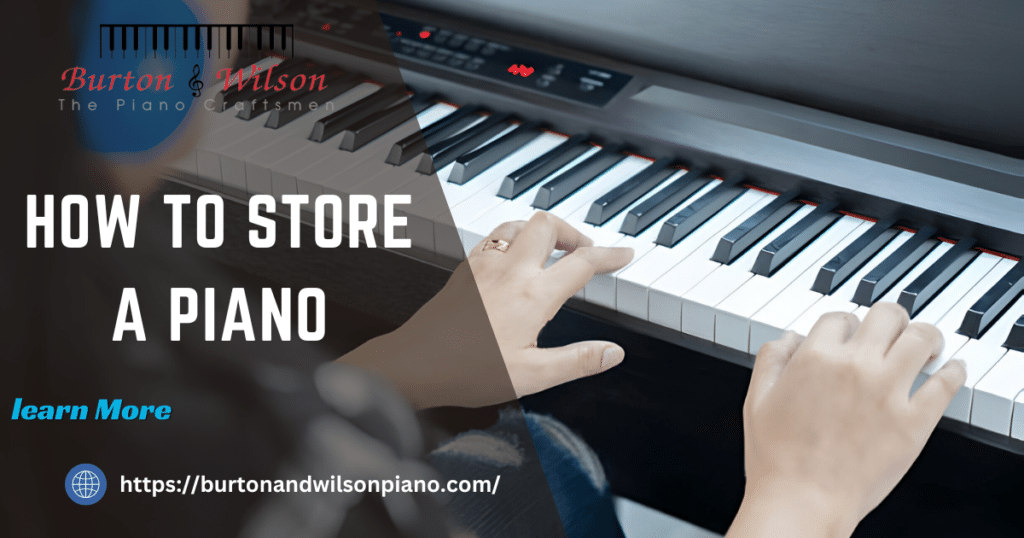How to store a Piano? Pianos are extremely fragile and need special treatment to reduce the risk of damage. The piano storage bay area process we provide is step-by-step and includes all the tips you will ever need.
Step 1 – Find the best storage space
Step 2. Assemble all the necessary packing and storage material
Step 3. Thoroughly clean, polish, and refinish your piano
Step 4 – Cover the keys with a cloth to prevent dust from accumulating
Remove wheels or casters
Step 6: Secure music stands
Step 1: Determine The Best Storage Space
Pianos can be extremely fragile and sensitive to temperature or climate change. Piano manufacturers recommend, for instance, that pianos should be stored at a stable temperature with humidity no greater than 42%. As a result, it is important to select the storage area carefully.
The traditional self-storage space is not protected against environmental factors. If the air is humid, then so will the storage space.
Your piano will also suffer if you have a sudden cold or heat wave. You should choose a safe storage company that offers climate control and protection against other environmental elements, such as dust, dirt, or pests.
Assemble The Packing And Storage Materials
To properly store this treasured item, it is important to use quality storage material. If you want to store a piano, you must do the following.
- Heavy-duty moving sheets protect your piano from scratches, bumps, and dents in transit or storage.
- Protective plastic wrapping: protects your piano against bumps and scratches while in transit or storage.
- Use heavy-duty packing tapes, straps, or ropes to fasten moving blankets around a piano.
- Furniture straps can help you move the piano more easily by hand.
- A moving dolly is a necessity. You should only purchase a dolly equipped with four heavy-duty wheels.
- It’s important to choose a moving vehicle with a lift. If this is impossible, you should look for a truck with an accessible loading ramp.
Getting your piano on the truck as easily as possible is important to avoid any damage or breakage. Lifting your piano onto the truck is much more difficult than using a ramp or lift. This is safer for your back.
Step 3: Completely Clean And Polish Your Piano
The cleaner your instrument is, the better it will look when you pull it out of storage. First, check the manufacturer’s instructions on how to clean and polish your piano. Then:
- Use a feather duster to remove any dust. It would help if you were very gentle, as even dust could scratch the surface and leave a permanent mark.
- Wet a white, lintless cloth (squeezing out excess liquid) and then dampen the cloth. Use the dampened cloth to clean the keys of dust or dirt.
Wipe the keys immediately with a dry towel to remove any moisture. It is better to use an up-and-down motion than a sideways motion, which can force dirt and dust into the gaps between keys.
- Wet a soft white cloth (wringing it out to remove any excess liquid) and dampen it. Use the dampened cloth to wipe the piano’s exterior surfaces. This will remove any dust or dirt. To remove any excess moisture, be sure to dry all surfaces immediately.
- Polish the outer surfaces of your keyboard using a lint-free soft cloth. Be gentle when applying the polish, and always apply it toward the grain.
Remember that you should only use a specifically manufactured piano polish, not general-purpose furniture polish, as this can damage your piano. Only polish your piano when it is really necessary. Polish can damage the delicate internal mechanisms in a piano.
- Ensure your piano is dust- and moisture-free before wrapping or storing it.
Avoid tuning your piano before piano storage bay area. Tune your instrument after it has been removed from storage. It would help to let your piano adjust to its new surroundings before tuning it. It is best to leave it for at least two weeks after removing it.
Step 4: Cover Keys To Keep Dust Away
Piano keys are fragile and must be protected during storage and when moving. Now is the perfect time to purchase a dust protector for your piano keys if you don’t have one already. Use a white, soft, lintless cloth that is the appropriate size.
Put your cloth or key protector on the piano keys and close the lid. If your piano lid has no lock, you can secure it with tape. Remember that some packing tapes can leave sticky residue on piano lids.
Step 5: Remove The Wheels Or Casters
You must remove all wheels and casters at the base of your piano storage bay area it safely. It would help if you did not try to move the piano with its metal wheels.
Most of these wheels are decorative and intended to move the piano from one room to another, not onto a truck or down a corridor.
Step 6: Secure the Music Stand
Ensure that any music stands you use are flush and flat against the side of your piano. Securing the stand against the side of the keyboard is a good idea. However, some packing tapes are known to leave sticky residues.
Step 5: Wrap your Piano
Wrap the entire piano in heavy-duty moving sheets to prevent scratches and marks during transit and storage. Make sure that you cover all surfaces of the piano.
After wrapping your piano in moving sheets, you can secure it with straps, packing tape, or ropes.
Step 6: Hire Professional Removers
To properly do piano storage bay area, it is best to enlist the assistance of piano removalists. It is possible to damage your piano irreparably during transit. Professionals like Burton & Wilson will greatly reduce the risk.


 COCKTAILS & More
COCKTAILS & More